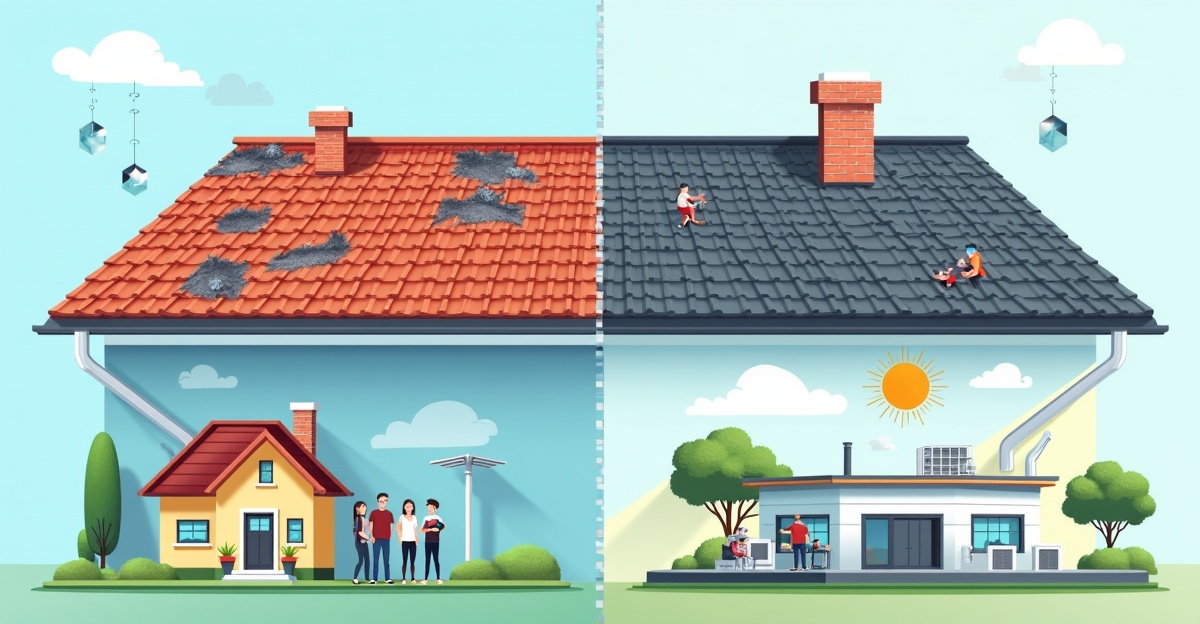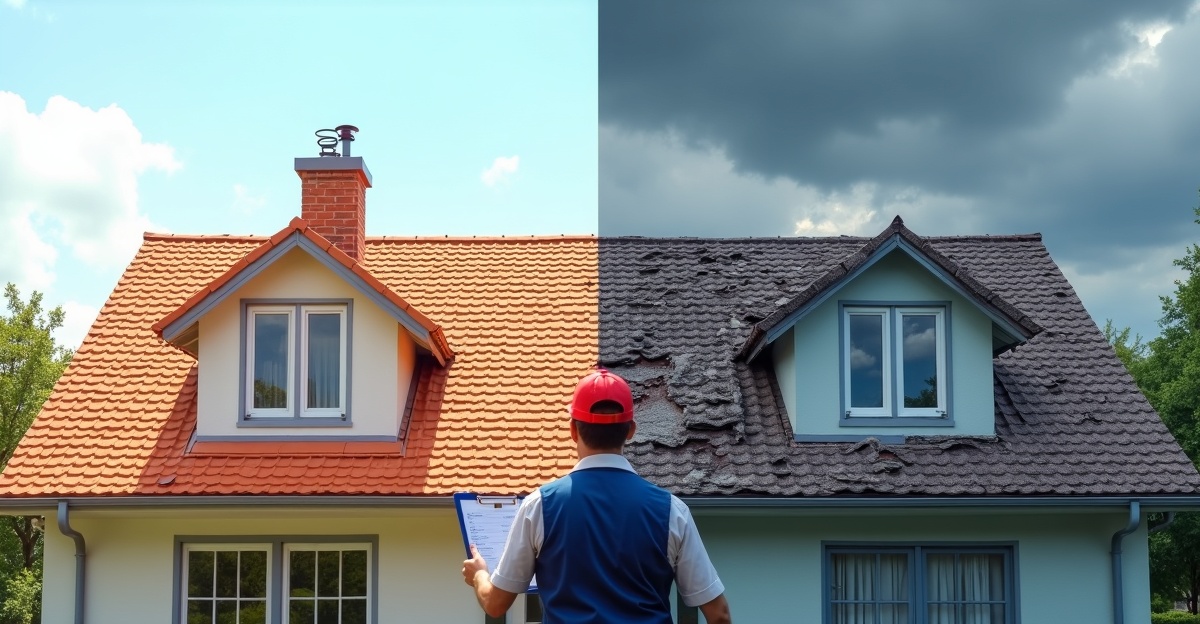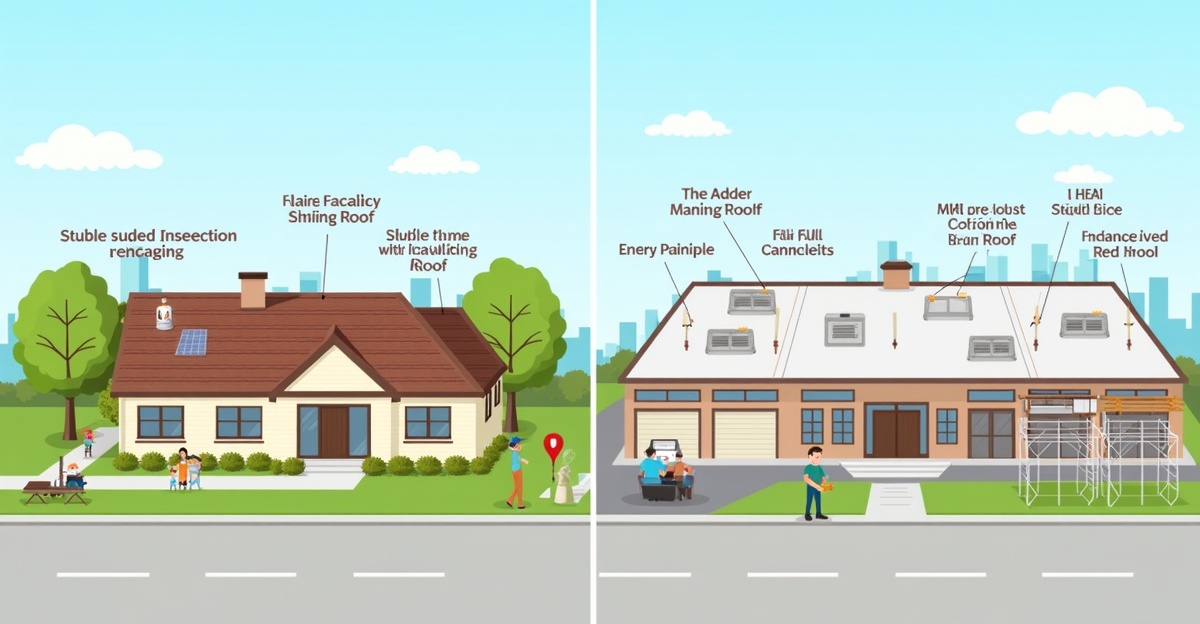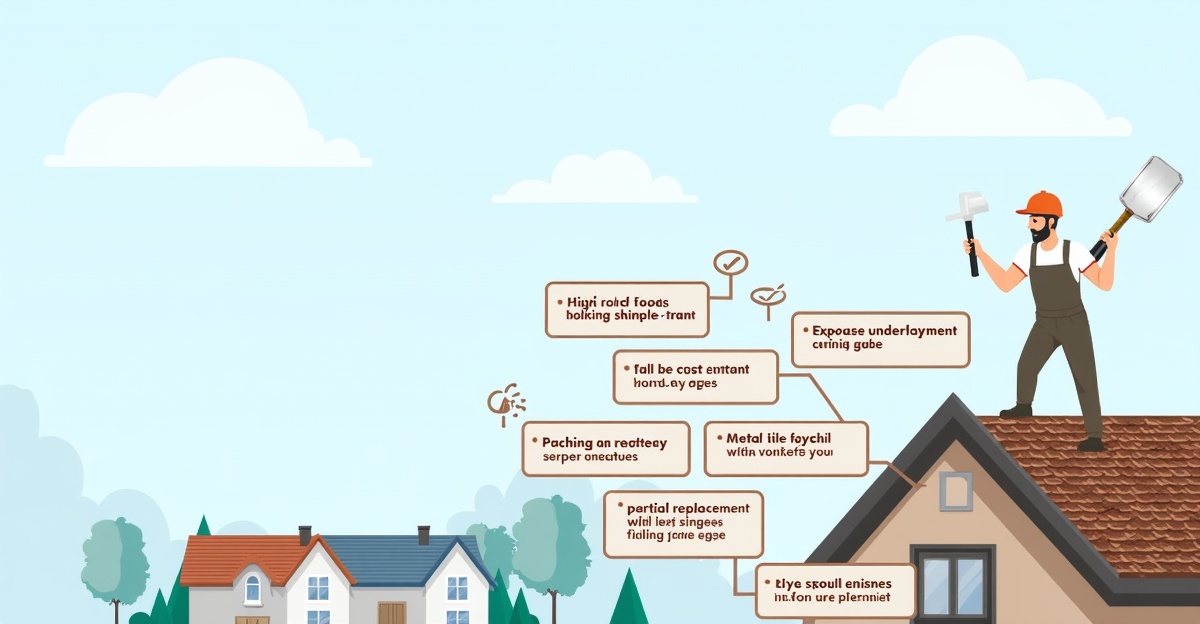Roof Repair or Replace? How to Decide

Deciding between roof repair and replacement involves more than spotting visible damage. We need to look at the roof’s age, its current shape, and how well it performs. Whether we’re dealing with leaks, weakened structure, or worn-out materials, we must weigh the short fixes against long-term results.
Key Takeaways
- Small, localized issues—like missing shingles or minor leaks—can often be fixed. But if damage keeps showing up or covers a large area, replacement becomes the smarter option.
- Age plays a big role. Asphalt roofs nearing 20 years usually deliver better value through full replacement rather than continued repair.
- Fixes cost less at first but can become expensive over time. Replacing the roof can lead to stronger returns through better energy performance, fewer maintenance needs, and longer coverage.
- How we use the property—home or business—shapes the better decision. Think about future sale plans, legal standards, and exposure to tough weather.
- A certified inspection tells us whether we can repair with confidence or should commit to a full update.

Know the Key Triggers: When to Repair and When to Replace
Deciding between roof repair vs replacement starts with knowing what your roof’s telling you. Some red flags say “patch me up”, while others scream “start over.” Let’s break it down.
How to Read the Warning Signs
Certain symptoms point to short-term fixes. Others signal deeper issues that repair won’t solve. Here’s what we look for during a roof assessment:
- Visible damage: A few missing shingles or a small leak near the flashing may need just a basic repair. But ponding water, sagging rafters, or drooping areas? Those usually mean the structure underneath is compromised.
- Age of the roof: Materials have lifespans—once you’re in the final stretch, replacement often makes more sense than chasing repairs.
- Asphalt shingles: 15–30 years
- Metal roofing: 40–70 years
- EPDM or membrane roofs: 20–35 years
- Tile and slate roofs: 50–100+ years
- Recurring problems: If you’re seeing new issues after every storm or calling for repairs every few months, you’re likely patching a bigger problem. In some cases, the total cost of repeat repairs can get close to—or even exceed—the price of a new system.
Often it’s not about one single factor, but how they add up. A 20-year-old asphalt roof in solid condition might buy you more time. But a 15-year-old one with curling shingles, visible water damage, and poor ventilation? Replacement’s going to save you money and frustration long-term.
We also recommend watching for some of the more serious signs you need a new roof:
- Granules collecting in gutters or around downspouts
- Shingles curling, cracking, or becoming brittle
- Soft or sagging spots in the roof deck
- Frequent leaks, especially in multiple areas
- Mold or mildew on interior ceilings or attic
These aren’t just cosmetic—they’re signs your roof’s near or past its limit. If that’s where you are, check out this guide on signs you need a new roof for more detailed help.
Repairs usually solve isolated, early-stage issues. But if we see structural concerns, widespread material failure, or signs the system’s breaking down as a whole, replacement’s the smarter call. Often, especially with repeat issues, you’ll find your total repair bills are already closing in on the cost of a roof replacement.
Still not sure? You can also check out our tips on how to tell if your roof needs replacement—we lay it out clearly, with real-world examples.
Bottom line: Trust the signs. They tell you when it’s time to stop fixing and start fresh. We just make sure you’re looking in the right places.

Compare the Bottom Line: Cost, Timeline, and ROI
Choosing between roofing repair or replacement isn’t just about the upfront cost—it’s about real value over time. We always weigh the total picture: lifespan extension, long-term savings, stress reduction, and how each path affects the roof’s durability, performance, and resale impact.
Quick Comparison: Roof Repair vs. Replacement
- Repair Cost: $400–$4,000
- Replacement Cost: $7,000–$70,000+
- Repair Timeline: 1–7 days
- Replacement Timeline: 1–3 weeks
- ROI (Repair): Lower cost upfront, limited return—mainly defers bigger expenses
- ROI (Replacement): Higher upfront cost, but boosts energy efficiency, cuts future repair needs, and increases property value
The residential roof replacement cost may feel steep, but it often pays off through longer service life, fewer headaches, and higher resale appeal. Especially if the roof is 15+ years old or has widespread issues, a full replacement avoids the trap of patching over problems.
For owners focused on compliance or warranty coverage, especially in commercial settings, replacement provides a fresh start with full-code builds and extended manufacturer warranties. It’s not just smart—it puts you back in control.
On the flip side, if the structure is younger and the damage is localized, roof repair could be the smart move. Repairs are good stopgaps, but don’t expect them to last the way a rebuild would. Typically, repairs stretch a roof’s lifespan by a few years, but only if there’s no underlying damage.
Thinking long-term, the benefits of roof replacement outweigh short-term fixes in several key areas:
- Adds 20–50 years of roof life (depending on material)
- Cuts frequent maintenance calls
- Enables better insulation and energy performance
- Increases resale value—especially with updated shingles or energy-efficient materials
If you’re trying to figure out if it’s repairable or if your money’s better spent on a replacement, start by reading these signs you need a new roof. We also break down how to tell if your roof really needs replacement.
Jumping into repairs may be cheaper in the moment, but it’s worth asking: Will you have peace of mind in a year, or will you be chasing leaks again? On the other hand, investing in a full roof replacement resets the clock—and for folks planning to stay put or sell in the next few years, it’s a smart play.

Tailored Factors that Affect Your Decision
No two buildings are the same. What makes sense for a suburban home might not work for a multi-unit facility in a tough climate. That’s why deciding between roof repair or replacement isn’t just about price—it’s about context. Here’s what we look at before making a call.
Key Considerations That Shape the Right Move
Every roof has a story. Knowing the backstory helps shape the smartest fix. Here’s what we weigh:
- Maintenance history: If the roof’s been regularly checked and maintained, a repair may earn you a few more good years. But if minor leaks have been ignored or flashing’s held together with tar, replacement often makes more financial sense. Frequent issues usually signal deeper wear.
- Your future plans: If you’re holding on to the property long-term or passing it to your kids, replacement often pays off in durability and lower upkeep. Selling soon? A clean repair with documentation might be enough to get through inspection. Leasing it out? Consider the risk of repeated calls from tenants before choosing a band-aid fix.
- Climate and exposure: Constant sun takes a toll on shingles, while freeze-thaw cycles can crack tiles and split seams. If your building regularly sees storms or hail, repair might just be a short break between bigger jobs. We often help clients in harsh zones layer short-term patching with long-term planning to budget smart.
- Material compatibility: Some materials, like metal and tile, allow for piecemeal repairs. But others, especially older shingles, can be tricky to match or may not bond well with new layers. Every material has its quirks, and some fixes just don’t hold up. Knowing the expected roof lifespan by material helps set realistic expectations.
- Warranty coverage: Patching a roof can void existing warranties if not done by a certified pro—or if incompatible materials are used. A full roof replacement often restarts your warranty coverage and gives peace of mind for decades. It’s worth reading the fine print before committing to a repair.
Looking at all these factors together gives you a clearer roadmap. For instance, an aging roof on a single-family rental might get a solid repair this year, with a full install planned for the next budget cycle. But that same roof on a primary residence with storm damage might justify a fresh start right now.
If you’re still unsure, here’s a guide on how to tell if your roof needs replacement. We’re always here to talk through options, walk the roof with you, and lay out a plan that fits the building—not just the budget.

What to Expect: Repair and Replacement Process Explained
We get it—roof work can feel like a big unknown. Whether you’re dealing with a leak, storm damage, or just wear and tear, knowing what to expect from the roofing repair process or a full replacement makes everything a lot less stressful. We’ll walk you through it from the first inspection to the final cleanup. Our goal is to keep things clear, safe, and smooth every step of the way.
The Roofing Repair Process
Roof repairs are usually fast, efficient, and cost-effective. These are ideal when the damage is isolated and your roof still has some years left in it. Here’s how we normally handle roof repairs:
- Inspection and Assessment – We start by climbing up, checking everything from shingles to flashing to underlayment. We’ll identify the source of the problem and figure out how far it’s spread.
- Replacing Damaged Materials – If we see cracked shingles, missing flashing, or worn-out sealant, we’ll swap those out. We work to keep the repaired area consistent in color and performance.
- Sealing and Reinforcement – We patch up weak spots, reinforce trouble areas, and seal everything to prevent new leaks from forming.
- Fast Turnaround, Low Impact – Most repairs take less than a day. You probably won’t need to move anything or change your routine. It’s all done before you know it.
If you’re unsure whether you need repairs or a bigger fix, our guide on the signs you need a new roof can help you compare red flags.
What Happens During a Full Roof Replacement
Replacing a roof is a bigger job than a repair—but it’s also a bigger investment in your home’s safety, performance, and resale value. People often make this move when the roof is aged, sagging, or past the point of patching. Here’s how each phase unfolds:
- Full Tear-Off or Overlay – In most cases, we remove every layer down to the decking so we can inspect the surface underneath. Occasionally, if the old shingles are in decent shape, we may do an overlay—but that depends on your roof’s structure and local codes.
- Decking Repairs – If we find rot or sag in the underlying wood structure, we handle that right away. Solid decking extends the life of the new roof.
- Material Delivery and Install – We coordinate delivery of shingles, underlayment, drip edge, flashing, and fasteners the day before or day of the job. Our crew installs everything professionally and with proper ventilation technique.
- Disposal and Cleanup – Old shingles and nails are safely removed and hauled off. We magnet-sweep your yard and walkways. You won’t have to worry about cleanup—we take care of it all.
- Final Inspection – We check that everything looks right, seals tight, and drains properly. Our own quality control means fewer surprises down the road.
Still debating whether to patch things up or go for a full install? Our article on how to tell if your roof needs replacement lays it out plain and simple.
Timing, Disruption, and Safety
Whether we’re doing repairs or a full swap, we respect your time and property. Most repairs finish in a few hours. A full replacement usually takes 1–3 days depending on weather, roof size, and material. Shingle roofs move faster; tile and metal systems take a bit longer.
We always work around weather forecasts to avoid unnecessary delays. If rain threatens, we tarp exposed areas and schedule carefully. We’re fully insured and follow safety codes, keeping your family and our crew protected from start to finish.
Expect some noise during tear-off and install. We recommend parking vehicles away from the work zone, securing pets, and covering valuables in the attic just in case any dust filters through. We tarp landscaping and use cleanup nets to catch debris.
If you want to explore ROI considerations and real numbers, our breakdown of the cost of roof replacement gives you a clear financial picture.
And if you’re trying to choose between doing it yourself or calling in pros, here’s the short truth: professional jobs come with warranties, permits, and peace of mind. We explain this more in our article on DIY vs professional roofing.
From start to finish, whether we’re handling a ripped shingle or installing a whole new residential roofing system, we’re here to do it right. You’ll always know what’s happening next—no guesswork, no surprises.

Different Needs for Homes vs Commercial Properties
When we help decide between roof repair or replacement, we look closely at how your property is used. Residential and commercial roofs play very different roles. That’s why the decision—and the investment behind it—should reflect those unique demands.
Residential Roofing Priorities
For homes, the top concerns are about comfort, safety, and how everything looks from the street. A leaky or worn-out roof isn’t just a drip—it’s a stressor on your family and your property’s value. Here’s what usually drives a homeowner’s decision:
- Family comfort and safety: A roof that leaks, sags, or has missing shingles can lead to mold, weakened structure, and energy loss. That puts your home and your health at risk.
- Curb appeal: Whether you plan to stay for decades or sell in a year, a solid roof uplifts any home’s look—and resale value.
- Budget and financing: The average residential roof replacement cost can be a big number. We’ve seen everything from emergency patchwork to full replacements financed over time.
- Long-term peace of mind: Homeowners usually choose the best roofing materials for longevity like architectural shingles or impact-resistant options—especially in areas with seasonal storms or hail.
Here’s a helpful tip: Plan a roof walk-through at least once a year. Create a simple checklist—look for missing shingles, clogged gutters, water stains in the attic, and damaged flashing. It’s an easy Saturday morning project that can prevent surprise repairs later.
An example: One of our clients reached out after a hailstorm tore through their neighborhood. With the immediate damage and an aging roof, we helped guide them from a temporary fix to scheduling a full roof replacement within weeks—before leaks could affect insulation or drywall.
Commercial Roofing Priorities
Institutional and commercial buildings require a longer lens. Maintenance isn’t about curb appeal—it’s about business continuity, compliance, and managing assets across years, sometimes decades. Factors we focus on include:
- Minimizing disruption: Business owners don’t want loud work disrupting customers or employees. We often schedule commercial replacements around off-hours or seasonal downtimes—like a recent school project we took on during summer break to avoid interrupting classes.
- Compliance and warranty: Most commercial roofs must pass regular inspections to maintain code requirements or warranties. Skip a repair, and you may void thousands in future coverage.
- Energy efficiency: Roof replacements are a great time to upgrade insulation and lower long-term utility costs. Some materials even qualify for rebates, cutting expenses over time.
- Budgeting strategy: The true commercial roof repair cost depends not just on material and labor, but also access, scheduling constraints, permits, and how much can be written into the capital plan. That’s why we recommend making roof planning part of your annual CAPEX cycle.
- Multi-property coordination: Property managers working on retail sites or franchise buildings need support across locations—we help standardize materials and timelines to avoid inconsistent upkeep.
Here’s a quick tip for facility managers: Build a roofing file for each property. Include every inspection, repair, warranty paper, and photo. It’ll save hours when budget season rolls around or when a fast quote is needed.
Knowing when to repair or replace isn’t just about visible damage. There’s often a lot riding on the timing—especially in commercial buildings that can’t afford downtime. If you’re unsure, check out this simple guide on signs you need a new roof before the next inspection or storm season.
Whether it’s a home or business, we’ll help you make the call with facts, not guesswork. For installs, repairs, or planning down the road, see what’s covered under our residential roofing or commercial roof repair services.

Clear Your Doubts: FAQs and Common Misconceptions
Answers to the Questions We Hear Most
We’ve handled roofs in all conditions and at every stage of life. These are the questions that come up time and again—the kind that keep property owners second-guessing their next move. Let’s clear up the confusion.
“Is patching a roof just delaying the inevitable?”
Not always. If the roof is fairly new and the damage is isolated—like from wind-lifted shingles or a tree limb—then repairs can take care of it. But if the problem keeps coming back, you’re burning money on short-term fixes. The better option might be to look at a full replacement that stops the leaks for good.
“Can I replace just part of my roof?”
Technically, yes. But partial replacements often create more trouble than they solve—mismatched shingles, uneven wear, and warranties that won’t fully apply. We recommend this only in rare cases, usually when the damage is truly contained and the rest of the roof has years left.
“How often should I get my roof inspected?”
We suggest a checkup once a year, ideally before or after storm season. Also, any time your neighborhood gets hit by hail or strong winds, it’s smart to bring in a pro. Use our free download—the “roof inspection checklist”—to review your own roof from the ground first. Then, if anything seems off, we’ll come take a closer look.
“What’s the first step if I’m still unsure?”
Start with a professional inspection—it’s low-risk, high-confidence insight. We walk you through the current condition, explain what’s urgent and what isn’t, and give you honest answers without the scare tactics. You’ll be in a better position to decide whether to repair or move forward with a new roof. If you want, we can also walk you through our repair-or-replace decision matrix—a simple tool that weighs cost, age, performance, and peace of mind.
“How long does a roof last, really?”
Depends on the material. Asphalt shingles—the most common—usually last 20 to 30 years. Metal can go beyond 40. Tile roofs push beyond 50 with good care. These aren’t guesses. Learn more about how long a roof lasts based on real conditions and not just manufacturer promises.
“I don’t see any leaks—do I still need to think about replacing it?”
Leaks are only one symptom. Curling, bald shingles, sagging spots, and daylight showing through the attic signal bigger problems. If you’re past the 20-year mark, the issue may not be visible—yet. Check out the full list of warning signs you need a new roof before mold or rot sets in.
“Can I do the repair myself?”
We’ve seen folks climb up to save cash, but roofing isn’t just risky—it’s easy to miss signs that turn costly later. DIY might work for gutters or small fixes, but for anything more, your time and safety are best spent elsewhere. We explain why clearly in our article on DIY versus professional roofing.
“How much will a roof replacement set me back?”
The cost varies by size, material, pitch, and condition of the existing roof. We’re upfront about our pricing, and we never add surprises. Get a better idea of what affects the bottom line in our guide on the cost of roof replacement.
“What happens during a roof replacement?”
You’ll know what we’re doing each step of the way, from tearing off the old material to final cleanup. It’s noisy for a bit, but disruption is minimal. We keep the site safe, handle permits, and stay on schedule. Read more about what to expect during a roof replacement so there are no surprises when the crew shows up.
If you’re still on the fence, downloading our repair-or-replace matrix is a solid next step. You’ll get a clearer sense of where you stand—and when you’re ready, our team’s here to help with inspections, repairs, or full new roof installations. We give straight answers and stand behind our work. Every time.
